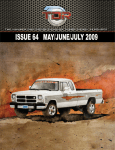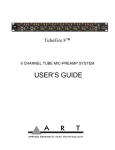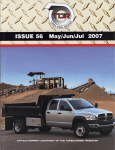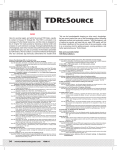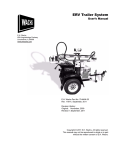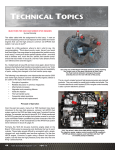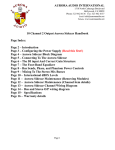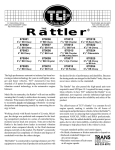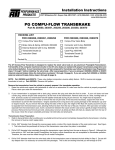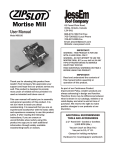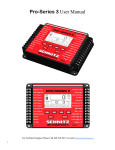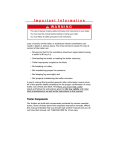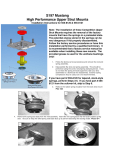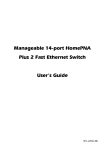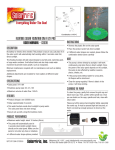Download PDF
Transcript
IT’S TIME TO INSPECT YOUR HARMONIC DAMPER (But please don’t call it a balancer) by David Magnoli As my truck nears the 90,000 mile mark, I thought I would take a look at the owner’s manual to see what the recommended maintenance was for that milestone just in case I were to forget, or was unaware of, some suggested repair. I always read the manual when I buy a vehicle, but often forget how much useful information is in it. Under the 90K schedule was the recommendation of “Inspect Damper”. I also noticed that this same prompt was listed at 30K and 60K. My first thought was that this referred to the steering damper (4x4). Not entirely sure, I looked it up in my service manual and found that it was not steering-related at all but was instead pointing me to that often overlooked, and for the most part, forgotten item more properly called the harmonic damper that sits on the front end of the engine’s crankshaft directly in front of, and part of, the serpentine-belt pulley. Like a lot of people, I suppose, I never paid much attention to this black doughnut, and did not realize that it required any sort of inspection or maintenance. It does in fact deserve our attention and in the process of doing so, I learned quite a bit about this important piece of our Mighty Cummins Diesel engine. What Is a Damper and What Does It Do? Although often referred to as the harmonic balancer, because our Cummins is internally balanced (the crankshaft itself being balanced), the damper on our engines does not balance the engine. It damps harmonic vibrations and, as such, is a harmonic damper. Other diesel pickup engines are externally balanced and in addition to the damper, have a counter-weight either made as part of the damper, or bolted on in addition to it to provide the balancing requirement. With each firing of the fuel/air charge in the cylinder, there is a violent but short-duration deformation or twist of the crankshaft as the force of the power stroke drives the crank against the resistance of the driveline. This occurs with each ignition event and results in the repeated twist and untwist of the crankshaft as this force alternately begins and ends, momentarily forcing the crank past its normal rotation, and then allowing the crank to rebound after each firing. This spring effect is more pronounced in a straight-six engine with its longer crankshaft than with the shorter crankshaft of a V configuration. It is also more pronounced at the front end of the crankshaft where there is less rotational resistance than at the transmission end. While the torque-converter or clutch/flywheel will offer minimal vibration damping at the rear of the engine due to their mass, they do nothing for the front end of the crankshaft, which will experience a greater degree of twist/rebound under power. This is also more of an issue in modified high-power engines with higher cylinder pressures and the associated higher crank torque-spikes. Varying with the speed and load of the engine, these firing impulses and rebound forces can, and do, set up harmonic and torsional vibrations in the crankshaft. And because it is the front of the crankshaft that drives the injector pump as well as the camshaft, increased vibrations and harmonic twisting can negatively affect their function as well. The 5.9 stock damper uses a rubber ring between the cast hub and the machined-steel pulley/inertia ring to dampen the firing impulses of the Cummins engine. This picture clearly shows the degradation of this rubber, as well as the section that is missing, which caused it to wobble on Cliff Scott’s engine. This should motivate the reader to inspect this important, but often-overlooked part, and make sure there are no signs of failure on your own truck. Surprisingly, the index marks are still in alignment on this damper, but this one should have been replaced some time ago. 44 www.turbodieselregister.com TDR 73 Our engine cranks have a natural resonance inherent to their design, which means that they tend to vibrate much more at certain specific frequencies than others. When the power pulses are in phase with this natural tendency to vibrate, this will result in lost horsepower, increased bearing wear, unstable valve and injectorpump operation as well as the effects being felt in the vehicle. Harmonics are the frequencies that are smaller, less pronounced multiples of the primary resonance. Everything has a natural resonance at which it will vibrate. Think of a piano with its many strings. The long and thick strings will vibrate slowly. Short and thinner wires will vibrate faster and, because they are connected to a soundboard, they allow you to hear these vibrations as sound. Hit a 2x4 with a hammer and it will vibrate also at a fixed frequency determined by its size, mass, and technical topics . . . . Continued physical shape. You can try this experiment to better understand the principles of native frequency and vibration. The next time you are standing on a single-span pedestrian bridge, such as one spanning a creek, stand in the middle of it and bounce up and down. You will feel its natural frequency as it shakes. If you time your bounces just right, and in cadence with and emphasizing this natural frequency, you can get the bridge moving up and down a surprising amount, much more so than if you were just walking across it. I am always astonished at how violently the bridge will shudder up and down if I continue this motion at just the right timing. Now imagine that in the center of this bouncing bridge you also have a 55-gallon drum filled with heavy gear-oil. Inside the drum and hanging suspended on a spring is a large, heavy steel washer that is allowed to move independently of the drum, which moves with the bridge. Now when you bounce on the bridge your motion is countered and dampened by the resistance of the weight moving against the oil. This is precisely what the engine damper on our truck is designed to do. The damper takes these short-duration shocks and absorbs them, thereby reducing the transmitted vibrations. The result is not only less stress and wear but also more usable power and a more stable valve train operation. part of the serpentine-belt pulley that drives the A/C, water pump alternator, and steering pump. There is a difference, however, in how this damper works on 5.9 and 6.7 engines. On the 5.9 engines there is a cast-iron hub which bolts to the engine crankshaft. The serpentine pulley is not part of this hub, but is machined as part of the heavy, outer steel inertia ring. Between this hub and the pulley/inertia ring is a layer of rubber that separates the two and is bonded to both. It is this tuned-rubber ring that allows the damper to work by allowing the two parts to flex and move independently of each other, damping out the firing impulses and converting this energy to heat. The stiffness and thickness of this rubber ring is designed to cancel out a specific frequency of vibration, determined by fueling, RPM, engine load, etc. and is limited to a very narrow band of resonance, that which the engineers have decided is needed. Due to engine heat, age, and continuous flexing, this rubber will deteriorate over time, becoming less effective. Because the pulley is being driven by rubber, as opposed to being part of the hub itself, when the damper deteriorates, it also affects the alignment of the pulley to the belt. Starting in 2007.5 with the 6.7 engines Cummins changed the damper design, foregoing the rubber in favor of a viscous-damped type. This damper works by enclosing an inertia ring inside a housing that contains a thick silicone fluid. This allows the damper to be more effective at a much wider RPM range than the tunedrubber type used on the earlier trucks. Because the inertia ring is now floating in a thick viscous fluid rather than being a bonded mechanical connection, it offers a variable resistance to the firing impulses and therefore is better suited to countering them and canceling vibrations. I’ll talk more about this type when discussing the aftermarket dampers. These newer dampers do not require any periodic inspection, so the rest of this article applies primarily to 5.9-liter equipped trucks. The pulley side of the stock damper shows the bonded rubber ring squeezing out from the gap between the hub and the inertia ring. The Service Manual clearly states that any protrusion beyond the face of the ring other than a slight convexity requires the replacement of the damper, as this indicates the beginning of the failure of the rubber. Although there are no missing sections on this side of the damper, the fact that the ring is so far out of the gap indicates a failure of the damper. The Stock Damper The stock 5.9 damper, in good working condition, for the most part works well with the stock engine it was designed for. But when we add power and increase these internal forces, or as it ages, the stock damper may not be up to the task anymore. The engineers that design the stock damper do so with our engines’ stock horsepower and native frequency (RPM, crank weight, and load) in mind and try to design the damper to be effective at the most offending part of the power band by using a tuned damper designed to address a certain range of vibrations. The harmonic damper bolts to the front flange of the crankshaft and is built as This shows the stock damper in good usable condition. Notice the rubber ring compared to the previous picture, and how it is flush with the hub and inertia ring. The two holes at the bottom of the picture on the damper were drilled when the damper was balanced. This damper is off of my 2001 with less than 90K miles and has seen much less severe use than the other damper, which has seen many high-powered miles towing more than 13,000 pounds. TDR 73 www.turbodieselregister.com 45 technical topics . . . . Continued The Need for Inspection and Replacement Replacement Choices An index mark on the 5.9 dampers, in the form of an inscribed line, crosses both the pulley hub and the pulley/inertia ring so that you can see if there is any degradation of the damper, requiring its replacement. The service manual for my truck (2001) states that if this index line is more than 1/16” out of rotational alignment, the damper should be replaced. Another requirement for replacement is the migration of the rubber ring in a lateral direction, causing it to move out past the face of the inertia ring. This clearly indicates that the damper on our trucks is something that wears out over time and will need to be replaced at some point. The following story will show that this part is something that should be inspected as directed by the Owner’s Manual. When faced with the replacement of the harmonic damper you have several choices. You can use an OEM unit from the dealer, for which my local Dodge dealer quoted me $420 before tax. It was only $201.47 before tax directly from Cummins. You also have a couple of aftermarket choices. A few days before leaving to attend this year’s annual TDR May Madness event held in Pahrump, Nevada, longtime TDR member Cliff Scott was giving his 2001 truck an inspection when he noticed that the damper was wobbling when the engine was running. Upon closer inspection, Cliff noticed that not only was the inertia ring out of alignment with the hub, but there was a substantial amount of the rubber ring actually missing, as well as squeezing out of the space between the two. It is his damper I used in the previous photos. There are a few companies making what are essentially the stockstyle dampers, but if you want an improvement over stock, there are really only two choices that offer a high-performance model. Both of the following aftermarket dampers have what I feel is a definite advantage over the stock damper besides just better performance. The serpentine belt pulley is machined as part of the hub, and as such is driven directly by the engine, not by the transfer of power through rubber as in the stock design. This means that the pulley cannot become misaligned, even if the damping function were to fail or lessen in effectiveness. Nothing will ever be thrown off the crank from deterioration of a rubber part. Keep in mind that the prices I used below are list prices, street pricing is considerably less. Also, prices shown are for my 2001; other year models may vary slightly. He has close to 180K miles on his 2001 but the amount of damage tells me that this has been going on for some time, proving that the Owner’s Manual inspection recommendation should be wisely followed. Luckily for Cliff, I had a brand new Fluidampr sitting on my bench in preparation for this article and I offered it to him to use. He was able to install it and drove over 450 miles to Pahrump towing his fifth-wheel. He liked it so much I had to order another one and hope it would come in time for my review. While I have heard stories of stock tuned dampers coming off of the hub, and have seen the bolts broken or missing, as well as the cast hub cracked, I would hope that the driver would feel increased vibrations indicating that something was amiss before that would occur. However, the possibility for such failures does exist. If the failure proceeds slowly, the driver may not notice the increase in vibrations. The point here is not intended to alarm anyone though; it is simply to remind you to “Inspect Damper,” which should include checking the torque (92 ft-lbs) on the four mounting bolts. Even if your stock damper is not damaged, if you have substantially increased the power of your engine, your stock damper will most likely be out of its designed range. There was a substantial size difference between the 160 and the 215 horsepower dampers on the 12-valve engines, indicating that more power requires an increased level of damping. You can see this difference that was noted in TDR 18, page 23. The ATI Super Damper is supplied in three parts: the damper itself, the vehicle-specific hub, and the aluminum pulley. All necessary bolts and screws are supplied to assemble this damper, but it cannot be assembled before installation on the engine, due to the fact that the installation bolts do not fit through the crankshaft flange holes after it is assembled. It requires that the pulley and hub be bolted to the crank flange first, and then the damper ring is installed with the six Torx-Plus screws and six, 12-point cap bolts. Loctite 242 must be used and the torque values (printed on the damper label) must be followed. This is a reproduction of a marginal photo. The key item; yes, there is a size difference between the dampers. 160 on left, 215 on right. 46 www.turbodieselregister.com TDR 73 technical topics . . . . Continued ATI Super Damper Fluidampr The first option is the made-in-USA, ATI Super Damper at $475 list, which uses eight elastomer O-rings on a grooved, floating inertia ring housed inside an inner and outer shell that are pressed together and then bolted onto a vehicle-specific steel hub. There are three O-rings on the inside radius of the inertia ring as well as three on the outside. These contact the inner and outer surfaces of the two shells. The other two O-rings on the inertia ring contact the inside faces of the two shells. Each of these rings is made of varying density (durometer) designed to come into play at different RPM to manage variable harmonic vibrations. These dampers can be tuned for a specific application by varying the density of each of the elastomer O-rings. The Cummins version is larger and heavier than other applications, with the larger number of elastomer rings tuned to our engines. There is an important difference between this damper and the stock rubber-mounted one in that the O-rings offer a sliding surface rather than a bonded connection that is dependent upon the flex and rebound of the material. The inertia ring in the ATI is free-floating within the housing, allowing it to move and better absorb variable harmonics. When used in applications up to 800hp, they are rated to last 10 years and can be rebuilt by ATI, or by the user if you buy their kit, simply by taking the unit apart and replacing the rings. The second option is a Fluidampr at $436. This USA-made, allsteel product is supplied completely assembled and ready to install. This damper is made in six Cummins models, with the size, weight and characteristics designed specifically for each model/year of Cummins engines; it is not a one-size-fits-all. Dodge/Cummins changed to this type of viscous damper with the introduction of the 6.7 engine. They also exceed SFI 18.1specifications. The hub directly drives the pulley, eliminating any chance of belt alignment issues. The ATI arrives unassembled in three parts: the inertia ring, the vehicle-specific hub, and the aluminum pulley, each of which is zero-balanced to two-tenths of a gram. There is a dimple on the hub and ring which must be aligned. This damper must be installed on the engine in the following order, the pulley and hub first, and then the damper ring itself with the 12 supplied bolts and screws. This is because the washer-head crank flange bolts will not fit through the mounting holes after the damper ring is placed on the hub. New, longer crank-flange installation bolts are also supplied with the ATI because of the thicker hub. The stock bolts will not work with the Super Damper. It uses a steel inertia ring fitted inside a steel housing with a clearance gap that is filled with a thick silicone fluid, allowing it to float and mask vibrations over a much larger range of RPM than the stock, bonded type. Because it is insensitive to any specific frequency, it is able to self-tune to whatever vibration input it is exposed to. It is sealed and cannot be opened, and is maintenancefree for the life of the damper, which by design should never wear out. The machined, nylon-coated inertia ring is precision-balanced both before and after the coating process, and the balanced housing is laser-welded. The machined-steel serpentine-belt pulley is part of the hub and housing. The Fluidampr is also available for the 6.7-liter engines and includes the tone ring as part of the damper. The Fluidampr viscous design has been around since 1946 and also meets SFI 18.1 specifications. On any year truck, Fluidampr recommends the use of their available Cummins pinning kit to pin the damper to the crank flange if RPM are to exceed 3500. The kit is supplied with a drilling fixture, bit, and two hardened roll pins. On the left is the Fluidampr, larger in diameter and thicker than stock, and the heaviest of the three at 24 pounds. Next is the stock damper weighing in at 14 pounds, followed by the ATI Super Damper at 18 pounds. The ATI is smaller in diameter than the other two and also uses an aluminum pulley, unlike the steel used on the Fluidampr and the stock damper. The Fluidampr is a one-piece laser-welded assembly that is ready to install on your engine crankshaft. It is sealed and requires no maintenance. It is all steel and after coating the center-bore with anti-seize, installs in one piece. You will need to reuse your stock installation bolts or buy new ones, as none are supplied with this damper. The bolts are torqued to 92 ft-lbs. The pulley diameter remains the same on all three units, keeping accessories spinning at designed speeds. TDR 73 www.turbodieselregister.com 47 technical topics . . . . Continued The 6.7 Damper Another possible choice for replacing the tuned rubber style 5.9 damper is by using the 6.7 damper on a 5.9 engine. There has been talk of this on the TDR forums as well as other diesel forums, but I have not seen anyone actually do it yet. The fluid-type damper on the 6.7 engines is a dramatic improvement over the 5.9 design but it is not a direct bolt-on replacement. At the time of writing this article, I called Cummins West and my local Dodge dealer to see if they had one of the 6.7 dampers in stock and was told that neither they, nor the factory, had any available at that time. Being rather new, they are not at the point of failing yet, and there does not seem to be much call for them. There seems to be a clearance issue with the newer design on a 5.9 between the damper and the fan pulley, but I have not been able to get my hands on one to verify this. If these issues can be easily resolved, this may be another option for better performance. The damper is hub-centric and is aligned on the extension that is machined on the end of the crank, It is important when installing whichever damper you use, to use anti-seize or grease on this hub when fitting the new damper so as not to gall this close-fitting surface when turning the hub for bolt alignment. The Installation Process The 2011 6.7 Cummins engine uses a harmonic damper that is of the viscous-fluid type. This change from the tuned-rubber was made with the introduction of the 6.7 engine in 2007.5. The tone ring is part of the pulley on this damper. Enough Talk Already, Do They Really Work? So far the claims of the aftermarket manufacturers sound great, but I wanted to see for myself if they were valid. I put the Fluidampr and the ATI Super Damper through their paces by installing them on my 2001 Cummins to see how they would perform under various driving conditions in comparison to the stock damper. The first thing you will notice about these dampers is the weight. Mass is critical to being effective. A small, lightweight damper will not do much regardless of what method it uses to quell the vibrations, which work against this mass. You need the weight to counter the input energy. My stock damper weighs 14 pounds. The ATI tipped the scales at 18 pounds, a 4 pound increase over stock. The Fluidampr weighed-in at 24 pounds, a full 10 pounds heavier than the stock unit. Aftermarket dampers for First, Third, and Fourth-generation trucks vary slightly in weight from these, but all are substantially heavier than stock. 48 www.turbodieselregister.com TDR 73 The first step in the installation is to remove the belt. If your beltrouting diagram sticker is missing, draw the path or take a picture so you can re-install it properly. With an automatic transmission the engine turns as you remove the damper bolts, so I removed the small inspection plate under the torque-converter and used a pair of Vise-Grips on the flex-plate, cushioned with a piece of leather, and let it stop against the transmission housing. With a manual transmission just leave it in gear and set the parking brake. After removing the four 15 mm bolts that secure the damper, it is an easy removal, as it is not pressed onto the crankshaft. The dampers are hub-centric, having a close-fitting, center-bore that aligns with the machined snout on the end of the crankshaft flange. They are heavy though; be sure you get a good grip on it before removing that last bolt. After cleaning off the surface of the crank flange, and applying a little anti-seize compound around the center hole, I torqued the bolts to 92 ft-lbs as listed in the Service Manual. I used blue Loctite on these bolts, although there was none from the factory. I’ve read on the TDR forum that these bolts should not be reused as they are said to be torque-to-yield, but the Service Manual does not say anything about using new bolts. Obviously if they are damaged they should be replaced. Because I had torqued mine several times during the testing procedure, going back and forth between the different dampers, I replaced them with new bolts with the final installation. With the number of TDR forum posts about broken bolts, I would suggest that new bolts would be cheap insurance. The Cummins part number is 4937228 is for years ’07-current. The Cummins part number 3903857 is for years ’94-’06. technical topics . . . . Continued This shows the interference between the damper and the washer-head bolts on the ATI which requires this damper to be installed in separate steps. You can see the two bolts in the installed position, and the two that hang on the damper ring. After installing the hub and pulley on the engine, the damper ring is installed using the 12 supplied screws and bolts, using Loctite 242 and tightening to given specs. The ATI Super Damper in position on the crankshaft. It is smaller in diameter than the stock unit but is thicker and weighs an additional 4 pounds. The timing marks are of no use on our Cummins engine, but are there because this inertia ring shell has other applications that require them. This damper is made specific to a Cummins. You can read Scott Dalgleish’s article about changing a 12-valve damper in Issue 18, page 23. Also, in TDR Issue 52, page 28, there is a situation describing the alternator not charging due to the crank sensor not being in alignment with the timing notch on the damper. When installing on a 12-valve this is something to watch out for. Installation of both the ATI and the Fluidampr on my Second Generation 24-valve truck (’98.5-’02) did not require the removal of the fan or the radiator shroud, although it is recommended in the instructions. I was able to do the removal, although it is a bit tight, just by removing the belt and unbolting it. You can rotate the fan blades to a wide spacing to allow easier access. The ATI requires that you install the pulley and the hub to the crank first, and then the inertia ring can be mounted to the hub. It is a bit more difficult to do this with the fan shroud in place, but with a little patience it can be done. First and Second Generation 12-valve truck (1992-1998) installation is fairly straightforward. There is plenty of clearance to unbolt the old damper and install the new one after removing the belt. With the larger diameter of the Fluidampr, you will have to relocate and rewire the magnetic tach pickup from the top of the crank to the side and then adjust the clearance gap to the pickup, which is best measured before removal. The needed parts and instructions are included with the damper. The Fluidampr is one-half inch larger in diameter than the stock damper and weighs a full 10 pounds more. Along with this, it is also thicker than stock, but it has plenty of clearance once installed. Leaving the fan and shroud on was a bit of a knuckle-buster on my truck (2001), and other year models may require their removal. TDR 73 www.turbodieselregister.com 49 technical topics . . . . Continued Third Generation 5.9 trucks (’03-’07.5) and the 6.7 (’07.5-’09) have a slightly different installation due to the closer clearances. Again, the instructions state that the fan and shroud need to be removed, and although it does make it easier, I have seen it done on a ’04 without doing so. (Editor’s note: We also installed a Fluidampr on a Third Generation truck, a ‘03 model, without removing the fan.) However, the serpentine belt must be routed between the damper and the water-pump pulley before the Fluidampr is installed because of closer clearances with its larger diameter. This also means that to change the belt you must loosen or remove it also. This is not an issue with the ATI, due to its smaller diameter. Installation was easier since the Fluidampr is one piece, but that was only because I chose not to remove the fan and shroud. And because most of you will not be installing these four times in one day it will not really be an issue Road Test Results After installing each of these dampers I took the truck out for a test-drive to see if I could tell any difference between them and the stock unit. Keep in mind that this is not by any means scientific, but rather a seat-of-the-pants evaluation of these products. I don’t have the instruments to measure or record actual differences, only my impressions. I drove the truck all on the same day, changing dampers and going back over the same route for comparison. The truck was at operating temperature for each of the tests. I drove the truck with the various dampers as follows: stock, ATI, Fluidampr, and then stock again just to get a good feel for any differences. I drove for about an hour with each one installed and tried to cover many types of driving, from freeway to winding steep roads to stop and go traffic and was surprised to actually feel a significant difference. This was confirmed when I re-installed the stock damper and could feel the throb return. Idle Quality My truck does not have large injectors that cause a pronounced idle lope like some trucks do. The ECM (engine control module) does not have to work very hard to maintain idle speed. But there is always that slight throb at idle when in gear that disappeared with the ATI and Fluidampr installed. The truck is dead-still at idle. This was confirmed when I re-installed the stock damper and could feel the throb return. Manual-equipped trucks are said to have less gear clatter and to be smoother at idle with the installation of better dampers. I would think that a torque-converter, being a fluid-coupled device, would tend to be superior at absorbing vibrations at the rear of the engine than a clutch would, and would explain why manual transmission drivers would see a more dramatic idling improvement. Many claim reduced noise from the clutch. Also, with the installation of the damper on my friend Cliff Scott’s truck, he noted that the truck was easier to shift into reverse. 50 www.turbodieselregister.com TDR 73 Let’s Drive It At slow around-town speeds, there is nothing noticeably different about the aftermarket dampers, as the truck is not under much load under these conditions. Moving repeatedly from a stop did seem smoother with the two aftermarket models. The real differences are noticed when driving under increased load. Under hard acceleration there is a reduction in the vibrations with the ATI and Fluidampr over stock. The engine just feels smoother. On a long incline with my truck in overdrive going 50mph, I’m only spinning around 1400rpm with my 3.55 gears and the engine is almost lugging. Accelerating hard to 2000rpm repeatedly resulted in much less of the shuddering I am used to when driving on this road. The vibrations in the steering wheel and pedal were greatly reduced under the increased engine loading. Another area where I experienced a noticeable difference was at higher rpm. Accelerating in third from below 2000 to 3000 usually caused a dramatic increase in vibrations as the truck accelerated. This is also felt in the steering and the go-pedal. This has always been more noticeable with my Edge box turned up. With each of the aftermarket designs there was again a smoother overall feel under these higher power levels on the same stretch of road. As far as any differences between the Fluidampr and the ATI, it was hard for me to determine. I would give a slight edge to the Fluidampr at idle and lower rpm, possibly due to the increased weight over the ATI. But, at speed and under load, I could not tell any real difference, as both were so much better than the stock damper. The other thing to consider is that although I could definitely feel an improvement in performance under several conditions, this is a part that does its job protecting the engine even if you can’t feel it. A harmonic damper is not something that is designed or installed for the comfort of the driver; that is only a side benefit of it doing its job. In other words, it is designed to do a specific task. If you can feel the difference, great, but that is not the true test of its performance or protection. The fact is that the harmonic damper is protecting the engine, whether you can feel it working or not. Harmonic and torsional vibrations are very much an issue in our diesel engines, especially when power is increased, or when towing heavy; and, as mentioned before, the stock damper with its limited range of function only narrowly addresses this. Conclusion If your truck is stock, and your damper is in good condition, you probably do not need a better performing alternative although they are certainly a noticeable improvement. If however, you have substantially increased the power of your engine, I believe that you will benefit from the increased damping available from the aftermarket designs. The problem that I see with a stock-design 5.9 damper, and the reason that I feel the aftermarket designs are so much better, is that it really does not absorb the vibration as much as just delay it, or throw it out of phase slightly. This, along with the fact that the bonded rubber ring only allows a limited range of damping, contributes to the stock damper doing merely part of the job assigned to it. Increased horsepower places more demands technical topics . . . . Continued on our engines, and add to that the fact that the stock dampers do eventually wear out, and you have the need for an improved vibration-damping solution. The ATI and the Fluidampr actually absorb the vibrations resulting in a smoother and more effective damping of the engine’s resonance. Each of these designs allows the heavier internal inertia ring to float and move within the housing at a changeable amount dependent upon the varying inputs from the crankshaft. This allows them to self-tune to the variable inputs. They don’t store any energy like the stock one does. The ATI and Fluidampr are not only able to absorb more, but they also do it at a wider range of resonances, damping out the second, third, (and so on) order harmonics generated under increased engine loading. Being much heavier than stock means that there is more mass that the crank impulses have to work against and overcome, resulting in improved damping action. Another advantage is the fact that the pulley is part of the hub and not driven by a rubber ring, ensuring that the belt will always run true. If your damper has failed and you are looking for a replacement, I would strongly consider the aftermarket type. If you are the kind of guy that just wants the best performance and you don’t mind paying for it, you can replace your damper even if it does not show any signs of deterioration. Although that might seem wasteful, we tend to do exactly that with all the other parts of our trucks, often resulting in quite a few usable parts stacking up in our garages. Such is the diesel addiction. Although I was skeptical about the realworld advantages of these products, after my research and a direct comparison, I can clearly see the limitations of the stock units due to design and longevity issues and can very much feel the results of better damping. The two reviewed products have been around for a long time and have many miles of racing experience with highrpm and rough usage. The quality, tolerances, and finish of both are excellent. They are not inexpensive, but their effectiveness is well-proven. They work and your engine will thank you. David Magnoli TDR Writer Sources: ATI Performance Products 6747 Whitestone Road Baltimore, MD 21207 (410) 298-4343 www.atiracing.com Fluidampr by Horschel Motorsports 180 Zoar Valley Road Springville, NY 14141 (716) 592-1000 www.fluidampr.com TDR 73 www.turbodieselregister.com 51









